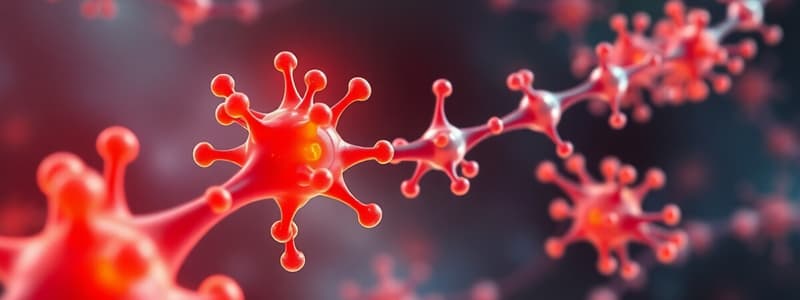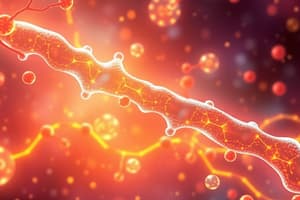Podcast
Questions and Answers
What is the primary indication for pilocarpine ophthalmic solution?
What is the primary indication for pilocarpine ophthalmic solution?
- Glaucoma (correct)
- Abdominal distention
- Xerostomia
- Postpartum urinary retention
Which structural feature of pilocarpine contributes to its limited ability to cross the blood-brain barrier?
Which structural feature of pilocarpine contributes to its limited ability to cross the blood-brain barrier?
- Imidazoline ring
- Lactone ring
- Pilocarpic acid formation
- Tertiary nitrogen (correct)
What is the approximate half-life of pilocarpine at a higher oral dose (10 mg)?
What is the approximate half-life of pilocarpine at a higher oral dose (10 mg)?
- 1 hour
- 2 hours (correct)
- 3 hours
- 5 hours
Which drug is used to treat xerostomia and is an agonist at central M1 and peripheral M3 receptors?
Which drug is used to treat xerostomia and is an agonist at central M1 and peripheral M3 receptors?
What is the primary route of elimination for cevimeline?
What is the primary route of elimination for cevimeline?
Which of these drugs is an alkaloid found in Areca nut and has been linked to carcinogenic effects?
Which of these drugs is an alkaloid found in Areca nut and has been linked to carcinogenic effects?
Which of the following structural features is NOT shared by pilocarpine, cevimeline, and arecoline?
Which of the following structural features is NOT shared by pilocarpine, cevimeline, and arecoline?
Which of these drugs does NOT strictly follow the classical structure-activity relationship of muscarinic agonists?
Which of these drugs does NOT strictly follow the classical structure-activity relationship of muscarinic agonists?
Which of the following is a characteristic of cholinergic nerve transmission?
Which of the following is a characteristic of cholinergic nerve transmission?
What is the primary function of the parasympathetic nervous system?
What is the primary function of the parasympathetic nervous system?
Which of the following statements accurately describes muscarinic receptors?
Which of the following statements accurately describes muscarinic receptors?
What is the role of the G-protein in the activation of muscarinic receptors?
What is the role of the G-protein in the activation of muscarinic receptors?
What is the primary function of the alpha-subunit of the G-protein in muscarinic receptor activation?
What is the primary function of the alpha-subunit of the G-protein in muscarinic receptor activation?
Which of the following is NOT a feature of G-protein coupled receptors (GPCRs) involved in muscarinic receptor activation?
Which of the following is NOT a feature of G-protein coupled receptors (GPCRs) involved in muscarinic receptor activation?
What is the main difference between direct and indirect acting cholinergic agonists?
What is the main difference between direct and indirect acting cholinergic agonists?
What is the primary role of acetylcholine in cholinergic nerve transmission?
What is the primary role of acetylcholine in cholinergic nerve transmission?
What is the half-life of mivacurium?
What is the half-life of mivacurium?
Which compound undergoes metabolism via hydroxylation to inactive metabolites?
Which compound undergoes metabolism via hydroxylation to inactive metabolites?
Which non-depolarizing agent is described as having a half-life of 90-120 minutes?
Which non-depolarizing agent is described as having a half-life of 90-120 minutes?
What effect does the A ring configuration of pancuronium have?
What effect does the A ring configuration of pancuronium have?
Which non-depolarizing agent has a lower muscarinic antagonist activity compared to pancuronium?
Which non-depolarizing agent has a lower muscarinic antagonist activity compared to pancuronium?
Which option correctly identifies a characteristic of vecuronium?
Which option correctly identifies a characteristic of vecuronium?
What is a known side effect of pancuronium?
What is a known side effect of pancuronium?
What is a distinguishing feature of doxacurium compared to mivacurium?
What is a distinguishing feature of doxacurium compared to mivacurium?
What is the primary mechanism of action for reversible acetylcholine esterase inhibitors?
What is the primary mechanism of action for reversible acetylcholine esterase inhibitors?
Which statement correctly describes the difference between physostigmine and neostigmine?
Which statement correctly describes the difference between physostigmine and neostigmine?
What is a characteristic of irreversible acetylcholine esterase inhibitors?
What is a characteristic of irreversible acetylcholine esterase inhibitors?
Which condition is physostigmine NOT indicated for?
Which condition is physostigmine NOT indicated for?
What is the mechanism by which carbamate AChE inhibitors affect acetylcholine esterase?
What is the mechanism by which carbamate AChE inhibitors affect acetylcholine esterase?
Which acetylcholine esterase inhibitor is associated with significant CNS penetration?
Which acetylcholine esterase inhibitor is associated with significant CNS penetration?
What is a major risk associated with exposure to irreversible acetylcholine esterase inhibitors?
What is a major risk associated with exposure to irreversible acetylcholine esterase inhibitors?
Which of the following best describes the elimination half-life of neostigmine?
Which of the following best describes the elimination half-life of neostigmine?
Which type of acetylcholine esterase inhibitor is primarily used as a warfare agent?
Which type of acetylcholine esterase inhibitor is primarily used as a warfare agent?
What effect does aging of the bond with irreversible AChE inhibitors have on the enzyme?
What effect does aging of the bond with irreversible AChE inhibitors have on the enzyme?
What is the main purpose of administering pralidoxime?
What is the main purpose of administering pralidoxime?
Which type of antagonist is classified as a nicotinic antagonist?
Which type of antagonist is classified as a nicotinic antagonist?
What is the primary indication for the use of glycopyrrolate?
What is the primary indication for the use of glycopyrrolate?
What is the primary function of nicotinic cholinergic receptors?
What is the primary function of nicotinic cholinergic receptors?
What is a characteristic of the nitrogen in direct muscarinic antagonists?
What is a characteristic of the nitrogen in direct muscarinic antagonists?
Which subunit combination is associated with the muscle contraction nicotinic receptor?
Which subunit combination is associated with the muscle contraction nicotinic receptor?
Why are muscarinic antagonists often used in ophthalmic examinations?
Why are muscarinic antagonists often used in ophthalmic examinations?
What distinguishes tiotropium from ipratropium?
What distinguishes tiotropium from ipratropium?
What is the role of acetylcholine esterase inhibitors in cholinergic transmission?
What is the role of acetylcholine esterase inhibitors in cholinergic transmission?
Atropine is contraindicated in which of the following conditions?
Atropine is contraindicated in which of the following conditions?
Which drug is a natural muscarinic agonist?
Which drug is a natural muscarinic agonist?
Which of the following structures is essential for the activity of cholinergics?
Which of the following structures is essential for the activity of cholinergics?
What is a notable effect of scopolamine compared to atropine?
What is a notable effect of scopolamine compared to atropine?
How do larger spacers than ethylene affect cholinergic activity?
How do larger spacers than ethylene affect cholinergic activity?
Which structural feature enhances the potency of direct muscarinic antagonists?
Which structural feature enhances the potency of direct muscarinic antagonists?
What is the primary physiological effect of cholinergic agonists?
What is the primary physiological effect of cholinergic agonists?
What is the primary mechanism of action for benzodiazepines in the context of seizures?
What is the primary mechanism of action for benzodiazepines in the context of seizures?
What type of drug is oxybutynin primarily used for?
What type of drug is oxybutynin primarily used for?
Which cholinergic substance primarily affects nicotinic receptors?
Which cholinergic substance primarily affects nicotinic receptors?
What is the significance of the ester bond in direct muscarinic antagonists?
What is the significance of the ester bond in direct muscarinic antagonists?
What does the mnemonic SLUDGE represent in relation to cholinergic effects?
What does the mnemonic SLUDGE represent in relation to cholinergic effects?
Which patient population would require caution when prescribing atropine?
Which patient population would require caution when prescribing atropine?
How does substitution in the β position of the molecule affect cholinergic receptor interaction?
How does substitution in the β position of the molecule affect cholinergic receptor interaction?
Which of the following is a characteristic of direct muscarinic agonists?
Which of the following is a characteristic of direct muscarinic agonists?
Which formulation is most commonly used for scopolamine administration?
Which formulation is most commonly used for scopolamine administration?
Which isoforms are identified as related to cognition and memory?
Which isoforms are identified as related to cognition and memory?
What is the primary pharmacokinetic feature of tiotropium?
What is the primary pharmacokinetic feature of tiotropium?
What effect does botulinum toxin have on cholinergic transmission?
What effect does botulinum toxin have on cholinergic transmission?
Flashcards
Cholinergic Agonists
Cholinergic Agonists
Substances that activate cholinergic receptors, mimicking acetylcholine.
Cholinergic Antagonists
Cholinergic Antagonists
Agents that block cholinergic receptors, inhibiting the action of acetylcholine.
Muscarinic Receptors
Muscarinic Receptors
Type of G-protein coupled receptors that respond to acetylcholine.
G-Protein Coupled Receptors (GPCRs)
G-Protein Coupled Receptors (GPCRs)
Signup and view all the flashcards
Secondary Messenger Cascade
Secondary Messenger Cascade
Signup and view all the flashcards
Agonist Binding Process
Agonist Binding Process
Signup and view all the flashcards
Acetylcholine
Acetylcholine
Signup and view all the flashcards
Pharmacokinetics of Muscarinic Agents
Pharmacokinetics of Muscarinic Agents
Signup and view all the flashcards
Pilocarpine
Pilocarpine
Signup and view all the flashcards
Indication of Pilocarpine
Indication of Pilocarpine
Signup and view all the flashcards
Cevimeline
Cevimeline
Signup and view all the flashcards
Mechanism of Cevimeline
Mechanism of Cevimeline
Signup and view all the flashcards
Arecoline
Arecoline
Signup and view all the flashcards
Indication of Arecoline
Indication of Arecoline
Signup and view all the flashcards
Pharmacokinetics of Cevimeline
Pharmacokinetics of Cevimeline
Signup and view all the flashcards
Pharmacokinetics of Pilocarpine
Pharmacokinetics of Pilocarpine
Signup and view all the flashcards
Duration of Mivacurium
Duration of Mivacurium
Signup and view all the flashcards
Doxacurium
Doxacurium
Signup and view all the flashcards
Pancuronium
Pancuronium
Signup and view all the flashcards
Vecuronium
Vecuronium
Signup and view all the flashcards
Mivacurium vs Doxacurium
Mivacurium vs Doxacurium
Signup and view all the flashcards
Mechanism of Pancuronium
Mechanism of Pancuronium
Signup and view all the flashcards
Mechanism of Vecuronium
Mechanism of Vecuronium
Signup and view all the flashcards
Histamine Release in Pancuronium
Histamine Release in Pancuronium
Signup and view all the flashcards
Indirect Cholinergic Agonists
Indirect Cholinergic Agonists
Signup and view all the flashcards
Acetylcholine Esterase
Acetylcholine Esterase
Signup and view all the flashcards
Reversible AChE Inhibitors
Reversible AChE Inhibitors
Signup and view all the flashcards
Irreversible AChE Inhibitors
Irreversible AChE Inhibitors
Signup and view all the flashcards
Physostigmine
Physostigmine
Signup and view all the flashcards
Neostigmine
Neostigmine
Signup and view all the flashcards
Carbamate Inhibitors
Carbamate Inhibitors
Signup and view all the flashcards
Cholinergic System
Cholinergic System
Signup and view all the flashcards
Organophosphate AChE Inhibitors
Organophosphate AChE Inhibitors
Signup and view all the flashcards
Aging of the Bond
Aging of the Bond
Signup and view all the flashcards
Nicotinic Receptors
Nicotinic Receptors
Signup and view all the flashcards
Subunit Isoforms
Subunit Isoforms
Signup and view all the flashcards
Muscle NIC Receptor
Muscle NIC Receptor
Signup and view all the flashcards
Cognition NIC Receptor
Cognition NIC Receptor
Signup and view all the flashcards
Cholinergic Drug Targets
Cholinergic Drug Targets
Signup and view all the flashcards
Parasympathomimetic Drugs
Parasympathomimetic Drugs
Signup and view all the flashcards
Natural Cholinergic Agonists
Natural Cholinergic Agonists
Signup and view all the flashcards
Essential SAR of Cholinergics
Essential SAR of Cholinergics
Signup and view all the flashcards
Cholinergic Effects (SLUDGE)
Cholinergic Effects (SLUDGE)
Signup and view all the flashcards
Agonist Activity Requirements
Agonist Activity Requirements
Signup and view all the flashcards
Antagonist Activity
Antagonist Activity
Signup and view all the flashcards
Stereoselectivity
Stereoselectivity
Signup and view all the flashcards
Alkyl Substitution Effects
Alkyl Substitution Effects
Signup and view all the flashcards
Ester Hydrolysis
Ester Hydrolysis
Signup and view all the flashcards
Acetylcholine Degradation
Acetylcholine Degradation
Signup and view all the flashcards
Pralidoxime
Pralidoxime
Signup and view all the flashcards
Benzodiazepines
Benzodiazepines
Signup and view all the flashcards
Muscarinic Antagonists
Muscarinic Antagonists
Signup and view all the flashcards
Nicotinic Antagonists
Nicotinic Antagonists
Signup and view all the flashcards
Mydriasis
Mydriasis
Signup and view all the flashcards
COPD Treatment
COPD Treatment
Signup and view all the flashcards
Atropine
Atropine
Signup and view all the flashcards
Scopolamine
Scopolamine
Signup and view all the flashcards
Tiotropium
Tiotropium
Signup and view all the flashcards
Ipratropium
Ipratropium
Signup and view all the flashcards
Oxybutynin
Oxybutynin
Signup and view all the flashcards
Glycopyrrolate
Glycopyrrolate
Signup and view all the flashcards
Receptor Interaction
Receptor Interaction
Signup and view all the flashcards
Half-Life
Half-Life
Signup and view all the flashcards
Pharmacokinetics
Pharmacokinetics
Signup and view all the flashcards
Study Notes
Integrated Sequence 2 – PHID1502 – Winter 2024-2025
- Course Topic: Medicinal Chemistry of cholinergic agonists and antagonists
- Required Reading: Foye's, Sixth Edition – Chapter 12, pages 361–391; Fifth Edition Online – Chapter 9
- Recommended Reading: Katzung, Eleventh Edition – Chapter 7, pages 95–112; Chapter 8, pages 113–126.
- Instructor: Oliver Grundmann, Ph.D.
- Instructor Contact Information: Phone: 352-246-4994; Email: [email protected]
Outline
- Review of the mechanism of action of direct and indirect-acting cholinergic agonists and antagonists
- Structure-activity relationship of muscarinic agonists and antagonists
- Pharmacokinetic properties and routes of metabolism of muscarinic agents
- Structure-activity relationship of nicotinic agonists and antagonists
- Pharmacokinetic properties and routes of metabolism of nicotinic agents
The Parasympathetic Nervous System
- Endogenous Substance: Acetylcholine
- System Function: Rest and digest response
- Includes diagrams of pathways and target organs
Cholinergic Nerve Transmission
- Neurotransmitter: Acetylcholine (ACh)
- Synthesis: Acetyl-CoA + choline → ACh
- Enzyme: Choline acetyltransferase (ChAT)
- Storage: Vesicles
- Release: Calcium influx triggers exocytosis
- Receptor Interaction: Binding to receptors
- Inactivation: Acetylcholinesterase (AChE) breaks down ACh into acetate and choline
- Diagrams showing the process
The Muscarinic Receptors
- Type: G-protein coupled receptors (GPCRs)
- Structure: Transmembrane region with 7 loops, binding site for drugs on the outside of the cell
- GPCR components:
- Transmembrane region with 7 loops
- Binding site for drugs on the outside of the cell
- Coupled G-protein
- Separate enzyme unit
- Functions of G-protein subunit diffusion initiate secondary messenger cascades
- Diagrams showing the functions of GPCRs
The Nicotinic Receptors
- Type: Ion channels
- Structure: 5 transmembrane subunits
- Acetylcholine binding site: Extracellular site
- Ion channel selectivity: For Na+, K+, and Ca2+
- Subunit variations: May account for genetic disorders
- Diagrams showing the location of acetylcholine binding site and structure of subunits
Subunit Types
- Muscle contraction (α₁)2β₁γδ and (α₁)2β₁γε
- Cognition and memory (α7)5, (α4)2(β2)3
- Pain perception ((a4)2(β2)3, (α3)2(β4)3)
- Brain reward ((α7)5, (α4)2(β2)3, (α3)2(β4)3)
- Subunits determine localization of specific receptor
Potential Drug Targets for Cholinergic Nerve Transmission
- Synthesis of acetylcholine (hemicholinum)
- Storage of acetylcholine in intracellular vesicles (vesamicol)
- Release of acetylcholine (botulinum toxin)
- Action on postsynaptic receptors (direct muscarinic and nicotinic agonists & antagonists)
- Degradation of acetylcholine (acetylcholine esterase inhibitors)
- Diagrams showing different stages of nerve transmission
Parasympathomimetic drugs/cholinergic agonists
- Pilocarpine, Physostigmine, and Echothiophate
- Types of cholinergic receptor
- Stimulation of the various receptors
- Indications and modes of administration
Natural Agonists at Cholinergic Receptors
- Muscarine (mushrooms) and Nicotine (tobacco)
- Effects on cholinergic receptors and organs
Essential SAR for Cholinergics
- Basic structure of cholinergics (acetylcholine)
- Acetyl is hydrophilic and provides necessary oxygen for receptor interaction . Choline is essential for receptor interaction and contains spacer (ethylene bridge) as well as basic nitrogen that can carry a positive charge
Cholinergic Effects - Mnemonic
- SLUDGE: Salivation, Lacrimation, Urination, Defecation, Gastrointestinal upset, and Emesis
- Direct and indirect muscarinic agonist effects
Essential SAR for Cholinergics (if R₁ = )
- Highest activity seen with nitrogen atom, requires possibility of carrying positive charge
- Methyl groups are required for agonist activity, larger substituents (ethyl groups) will confer antagonist activity
- Replacing methyl groups with hydrogen will lead to successively lower agonist activity
Essential SAR for Cholinergics (if R₂ = )
- Larger spacers than ethylene lead to reduced activity and may lead to antagonist effects (rule of five: not more than 5 atoms between the quaternary nitrogen and the terminal oxygen)
- Substitution of methyl group in β position leads to increased selectivity for muscarinic receptors, stereoselectivity (S) is equipotent with muscarine at muscarinic receptors while (R) isomer is 20 times less potent
- Substitution of methyl group in position a leads to decreased activity
Essential SAR for Cholinergics (if R₃ = )
- Potency and activity decrease with larger alkyl groups such as propionyl or butyl esters, aromatic substitution will lead to antagonist activity
- Ester is prone to rapid hydrolysis by ubiquitously present esterases
- Modification of ester does not affect selectivity for muscarinic vs. nicotinic receptors
- Replacement of methyl group with amine group (carbamate) results in more stable ester and longer duration of action
- Ether derivatives also provide for higher stability but are not used in the clinical setting
Ester Hydrolysis of Acetylcholine
- Acid hydrolysis: reversible until ester bond is cleaved
- Base hydrolysis: completely reversible, but favors cleaved product
- Diagrams of the reaction steps
Overview of Muscarinic Agents
- Direct muscarinic agonists
- Indirect muscarinic agonists
- Direct muscarinic antagonists
Direct Muscarinic Agonists
- Methacholine, carbachol, bethanechol
- Pilocarpine
- Cevimeline & arecoline
Direct Muscarinic Antagonists
- Atropine, scopolamine
- Tiotropium & ipratropium
- Oxybutynin & glycopyrrolate
- Trihexyphenidyl & tolterodine
- Solifenacin, darifenacin & propantheline
Overview of Nicotinic Agents
- Direct nicotinic agonists
- Direct nicotinic antagonists
- Depolarizing neuromuscular blocking agents
- Non-depolarizing neuromuscular blocking agents
Nicotinic Agonists
- Varenicline & epibatidine
Epibatidine
- Natural alkaloid isolated from skin glands of the Ecuadorian frog
- High affinity and agonist activity at nicotinic subtypes with predominantly central effects
Neuromuscular Blocking Agents
- Categorized into depolarizing and non-depolarizing agents
- High affinity for (α₁)2β₁γε nicotinic receptors on neuromuscular junction
- Used in general anesthesia, immobilization and prevention of muscle movement
- Used in endotracheal intubation
Depolarizing Agents
- Succinylcholine
- Decamethonium
- Mechanism of action, and their clinical implications
Depolarizing neuromuscular blocking agents
- Decamethonium
- Succinylcholine
- Mechanism of action, and clinical implications
Non-depolarizing agents
- Tubocurarine
- Atracurium
- Mivacurium
- Doxacurium
- Pancuronium
- Mechanism of action, duration of action and clinical implications
Non-depolarizing Agents - Classification
- Table listing drugs, potency, onset, half-life, and duration
Reversible Acetylcholine Esterase Inhibitors
- Physostigmine, neostigmine
- Pyridostigmine, carbaryl, and edrophonium
- Mechanism of action and their clinical efficacy
Irreversible Acetylcholine Esterase Inhibitors
- Echothiophate, Organophosphates, Insecticides
- Clinical relevance, mechanisms, specific examples
- Including indications and pharmacokinetics
Cholinergic Antagonists (Parasympatholytics)
- Categorized into muscarinic and nicotinic antagonists
- Muscarinic antagonists and their effects on specific organs and systems
- Nicotinic antagonists and their effects on neuromuscular junctions
Studying That Suits You
Use AI to generate personalized quizzes and flashcards to suit your learning preferences.





